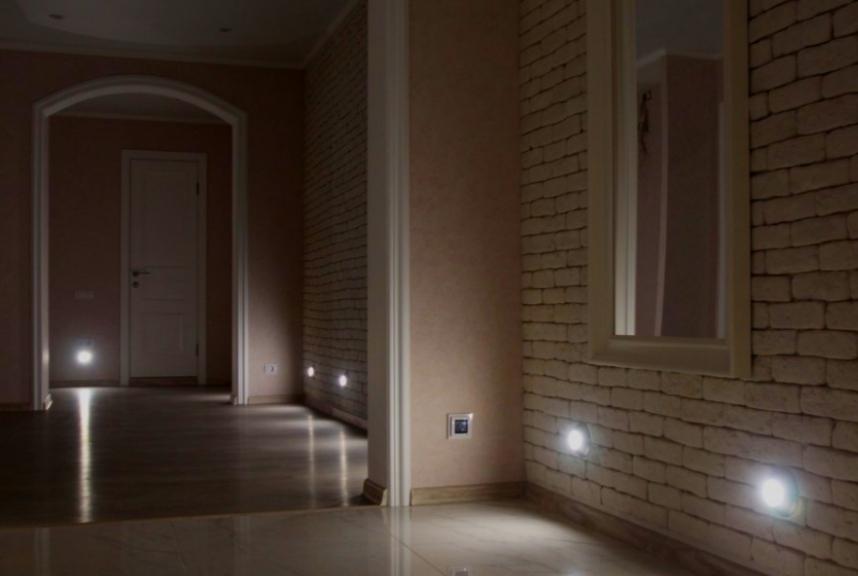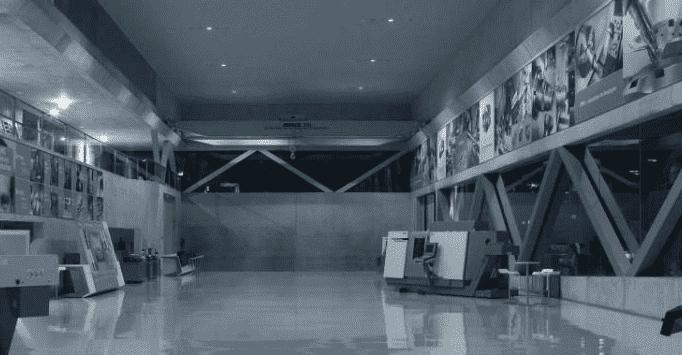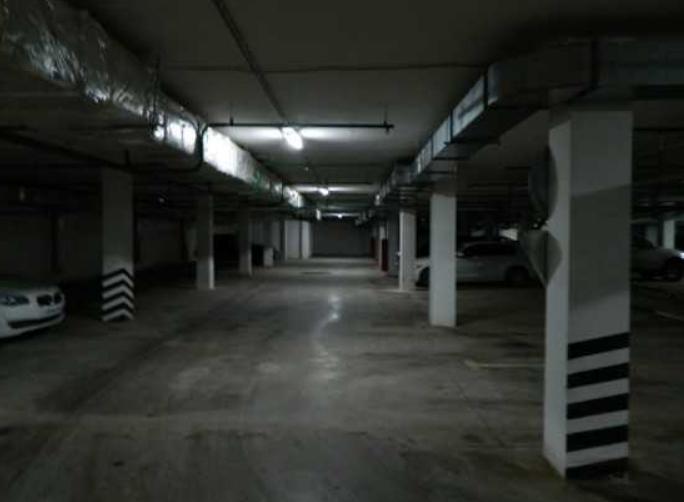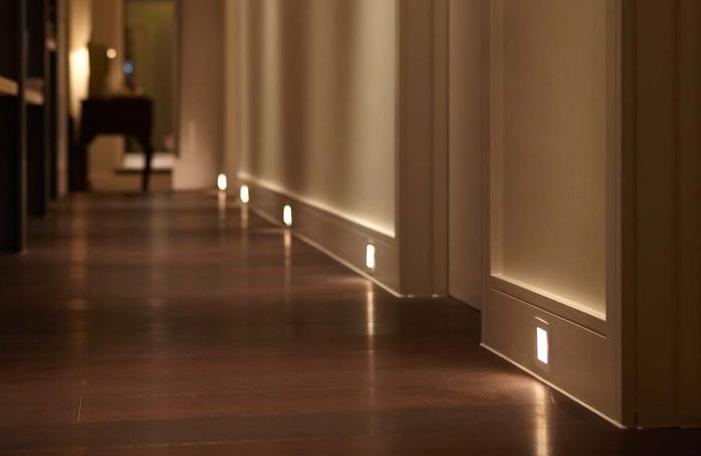Features of duty lighting
Duty lighting - a separate type of illumination used outside working hours and when the premises are few people. This option has its own features, which should be sorted out when designing the system, selecting models of lights and determining their location on the walls or ceiling.

Main differences, scope of application
Duty lighting is used at times when the number of people in the room is minimal or if they come in only occasionally. In normal natural light include artificial light sources is not required.
It should be understood that this option does not apply to emergency or evacuation lighting. But it can perform their functions, provided that the lights are connected to a separate line or have an autonomous power supply in case of power outages.

Features of standby lighting are as follows:
- It is used where it is necessary to provide round-the-clock illumination to ensure the safety of people.
- The light does not have to be bright, its main function is to create a backdrop in which it is comfortable to move along corridors, rooms, staircases, etc.
- Lights can be placed indoors and in underground parking lots or outdoor areas to provide visibility for pedestrians as well as cars or other vehicles.
- This light option is a must for hospitals and other medical facilities. It allows staff to walk around at night without disturbing patients in their rooms.
- In factories, warehouses, passageways and other places where people are not doing basic work are illuminated in this way.
- In various public places and establishments, the duty light works during off-hours, and during the rest of the time standard lighting should be used.

If you equip the lamps with motion sensors, the lights will only come on when they are needed. This is especially useful for stairwells, corridors and places where there is very little traffic after hours.
Advantages of standby lighting
This option is not mandatory when compared to emergency or evacuation lighting. But there are many benefits to using it:
- Ensuring normal visibility in corridors, stairwells, or adjacent areas. Now there is no need to use basic lighting at times when it is not particularly necessary.
- Energy savings. Using equipment with low power or running it on minimum settings reduces electricity consumption by a factor of 10 or more. And if you choose energy-saving luminaires, you can reduce the cost of lighting after hours to a minimum.
- It is possible to use luminaires with motion sensors. This will further reduce your energy costs, as the lights will only be on when there is a person around. The rest of the time, the equipment may not work if it is not necessary.
- If the lights work all the time, they also serve as protection against intruders. Thieves are much less likely to enter illuminated areas, it is easier for security personnel to conduct inspections, and with video surveillance, intrusion can be detected quickly.
- Luminaires can be used for other purposes. They can serve as emergency lighting if the power is out and people need to get out of the building. Often the main light equipment is used, which, when not in use, simply reduces the brightness by adjusting or by turning on a second light element.

You can set the standby light to start on time or it starts after you turn it on manually. Usually the main light is turned off and the standby light is turned on.
Technical standards for duty lighting
In the design and selection of equipment must take into account the recommendations of norms SNiP and GOST. For industrial plants and public buildings they are mandatory, for the private sector they are also best observed:
- The intensity of lighting should be 10 to 15% of the capacity of the main lighting fixtures. If the standard light is very bright, the values can be lower.
- The lowest value of illumination should be 1-2 lux per square meter. This is the minimum intensity allowed.
- Duty lighting very often also serves as an element of security. In this case the minimum illuminance value should not be less than 0.5 lux per square meter.
- Norms for this type of light are set for working surfaces. That is, if it is a table, you should measure at the height of the table top. And if we are talking about corridors, staircases, etc., the values are measured on the floor plane.

That said, there are also requirements for the types of lamps that should be used in standby lighting fixtures:
- Fluorescent lamps can be used in heated rooms where the temperature does not drop below 5 degrees. This option provides good light and consumes electricity economically.
- mercury lamps - Traditional solution, which is used less and less often due to the emergence of more efficient and economical alternatives. This option takes a long time to ignite, and after it is turned off, it takes a cool down to restart the light.
- Halogen lamps Halogen lamps give good light, but they use a lot of electricity and become very hot when they run. With constant use, energy costs will be high.
- LED lamps have a long service life (50,000 hours), so they last for decades. At the same time they consume the least amount of electricity and are unpretentious to external conditions, the light is of high quality, without flicker. You can change the brightness and set it exactly as required, if you install a dimmer.
- Incandescent bulbs are only used for standby lighting when no other options can be installed. They consume the most electricity and last the least.

By the way! For standby lighting, you can use LED strip. This option gives a soft diffused light, which is enough to provide visibility in corridors, stairwells and any other rooms. The tape can be installed anywhere, for the street there are options in moisture-proof silicone sheathing.
Tips for organizing standby lighting
To provide quality emergency lighting after hours and in conditions of poor visibility, it is necessary to comply with several recommendations. It all depends on the specific use, all the rules are in PUE (rules of installation of electrical systems), the relevant GOSTs and SNIP. To avoid any problems, you need to remember:
- The system should be developed at the stage of construction of the building or during major repairs. This takes into account both the requirements of the basic regulations, and industry documentation, if it has special requirements for duty lighting.
- It is best to consult a representative of the supervisory authority on the drafting of the project. Then you can initially do everything according to the established norms and avoid rework and unnecessary costs.
- Make a project as detailed as possible, specify the location of fixtures, their power and height of installation. Duty light can be implemented in different ways - at a low height from the floor, under the ceiling or elsewhere. There are no requirements for this option in terms of unevenness of illumination.
- If the duty lighting will be used as part of the SPZ (fire protection system), then you need to comply with the regulations for such options. In this case, electricity is supplied on a separate line to ensure operation in case of disruption of the main power supply. Luminaires must also be equipped with a battery in case the power supply is interrupted. At the same time, the autonomous operating time should be at least one hour.
- It is best to use LED equipment, it is suitable for both businesses and private homes. This is the most economical option that lasts a long time and allows you to adjust the light. If necessary, you can increase the brightness or dim it.
- If you do not need constant illumination, it is better to use lights with a motion sensor. They turn on only when needed and work for a limited time - usually 30 to 60 seconds if motion has stopped.
- You can use emergency and evacuation lights as duty lighting, if they are on all the time. In this case, there is no sense to put additional equipment.

It is easiest to install LED strip, because it does not need wiring, the system works on a 12 volt power supply, you can connect it even to the socket, and lighting is not dangerous even if damaged.
Duty lighting is needed to ensure normal visibility where it makes no sense to use the main light. It can be implemented in different ways, there are no strict limits and standards for uniformity. And for maximum economy, you can install motion sensors to light up the lamps only when there is someone nearby.
In conclusion, the video: LED strip lighting